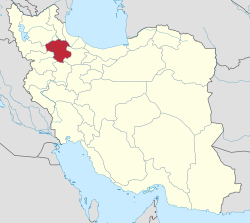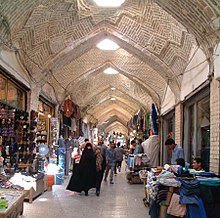Zanjan Province
Zanjan Province استان زنجان | |
|---|---|
Province | |
 Counties of Zanjan Province | |
 Location of Zanjan Province in Iran | |
| Coordinates: 36°40′30″N 48°29′04″E / 36.6751°N 48.4845°E / 36.6751; 48.4845Coordinates: 36°40′30″N 48°29′04″E / 36.6751°N 48.4845°E / 36.6751; 48.4845 | |
| Country | |
| Region | Region 3 |
| Capital | Zanjan |
| Counties | 8 |
| Government | |
| • Governor | Fathollah Haghighi |
| • MP of Assembly of Experts | Mohammad Reza Doulabi |
| • Representative of the Supreme Leader | Ali Khatami |
| Area | |
| • Total | 21,773 km2 (8,407 sq mi) |
| Population (2011)[1] | |
| • Total | 1,015,734 |
| • Density | 47/km2 (120/sq mi) |
| Time zone | UTC+03:30 (IRST) |
| • Summer (DST) | UTC+04:30 (IRST) |
| Main language(s) | Persian (official) local languages: Azerbaijani (Majority) Tati Kurdish[2] |
HDI (2017) | 0.771[3] high · 23th |
Zanjan Province (Persian: استان زنجان, Ostâne Zanjân; also Romanized as Ostān-e Zanjān; Azerbaijani: Zəngan ostanı, زنگان اوستانی, Зәнган останы) is one of the 31 provinces of Iran. Located in Iranian Azerbaijan with a largely Azerbaijani population.[4] it is part of Iran's Regions 3.[5] Its capital is Zanjan city. Zanjan province, with an area of 36,400 km², has a mostly rural population of 1,015,734 (2011).[1] The province lies 330 km northwest of Tehran, connected to it by a freeway. Zanjan is the happiest province in Iran.[6][7]
Contents
1 Agriculture and industry
2 Geography and climate
3 Demographics
4 History
5 Colleges and universities
6 External links
7 References
Agriculture and industry
Agriculture is the principal occupation, and crops include rice, corn (maize), oilseeds, fruits, and potatoes. Poultry, cattle, and sheep are raised.[8] In the region Zanjan is famous for its seedless grapes. Manufactures include bricks, cement, milled rice, and carpets. Chromium, lead, and copper are mined.[8] In the scientific world the Zanjan name is famous for IASBS, one of the most productive research centers of the country [1].
Zanjan is known for its beautiful handcrafts such as knives, traditional sandals called charoogh and malileh. Malileh is a handcraft made with silver wires. Zanjanian artists make many things like decorative dishes and their special covers as well as silver jewelry. In ancient times, Zanjan was known for its stainless and sharp knives. But this tradition is gradually becoming extinct by introduction of Chinese knives to the market which are cheaper and better made. Many villagers today are traditional carpet weavers. This is perhaps Zanjan's most popular handcraft.
The province economy is benefiting from the its location that connects central Iran to the northwestern provinces. The railway and highway that connects Iran's capital city Tehran to Tabriz, and Turkey passes through Zanjan Province.
Geography and climate
Zanjan has an area of 22,164 km², occupying 1.34% of the Iranian territory. The average population density in Zanjan is 4¼ people per km. In the northwest of Iran, Zanjan covers joint borders with seven provinces: East Azerbaijan, West Azerbaijan, Hamadan, Kurdistan, Gilan, Ghazvin and Ardabil.
Shahrestan, or counties, in Zanjan Province are:
- Abhar County
- Ijrud County
- Khodabandeh County
- Khorramdarreh County
- Zanjan County
- Tarom County
- Mahneshan County
- Soltaniyeh County
Zanjan has a highland climate characterized by cold snowy weather in the mountains and moderate climate in the plains in wintertime. In the summers, the weather is warm. The average maximum temperature of Zanjan is around 27 °C, whereas the average minimum temperature stands at -19 °C. Meanwhile, the temperature rises to 32 °C on hot days; it drops to -27 °C on icy days.[8]
The average annual rainfall in the first month of spring stands at 72 millimetres, while in the second month of summer, it slips to a meagre 3.6 mm. The rate of humidity in the morning stands by average at 74% and at noon at 43%.[8]
The Zanjān River is the only major river in the region.[8]
Demographics
Azeris are the main ethnic group in the province followed by Tats. Cities and villages in southwest of Zanjan province have Kurdish population.[2] Like every other part of Iran the lingua franca is Persian.
History
Zanjan city was a major city in pre-historic Azerbaijan. The name of Azerbaijan derives from Atropates,[9][10] an Iranian satrap of Media under the Achaemenid empire, who later was reinstated as the satrap of Media under Alexander of Macedonia.[11]
The original etymology of this name is thought to have its roots in the ancient Zoroastrianism, namely, in Avestan Frawardin Yasht ("Hymn to the Guardian Angels"). There is a mentioning of âterepâtahe ashaonô fravashîm ýazamaide, which literally translates from Old Persian as "we worship the Fravashi of the holy Atare-pata".[12]Atropates ruled over the region of present-day Iranian Azerbaijan.
In Ptolemy's Geography, the city is referred to as Aganzana. It is said that the Sassanid king Ardashir I of Persia, reconstructed the city and called it Shahin, but later it was renamed Zangan: the present name is the Arabicized form.
In past times Zanjan's name was Khamseh, which means "province with five tribes". Zanjan Province incorporates areas of the former Gerrus Province.
Colleges and universities

The Safavi era Bazaar of Zanjan
The Institute for Advanced Studies in Basic Sciences IASBS, in Zanjan city, is one of Iran's most distinguished upper-level education and research centers in the pure sciences. Zanjan is home to the University of Zanjan, Zanjan University of Medical Sciences, and Islamic Azad University of Zanjan.
External links
- Read more about zanjan in "Tebyan zanjan"
- University of Zanjan
- Islamic Azad University of Abhar
- Islamic Azad University of Zanjan
- Official website of Zanjan Governorship
- Iran Handcrafts & Handmade
- Sultaniyeh Dome Official website
- Zanjan University of Medical Sciences
- Zanjan City Information
| Wikimedia Commons has media related to Zanjan Province. |
References
^ ab Selected Findings of National Population and Housing Census 2011 Archived 31 May 2013 at the Wayback Machine
^ ab Government of Zanjan Province (Persian) Archived 22 July 2011 at the Wayback Machine.
^ "Sub-national HDI - Area Database - Global Data Lab". hdi.globaldatalab.org. Retrieved 2018-09-13..mw-parser-output cite.citationfont-style:inherit.mw-parser-output .citation qquotes:"""""""'""'".mw-parser-output .citation .cs1-lock-free abackground:url("//upload.wikimedia.org/wikipedia/commons/thumb/6/65/Lock-green.svg/9px-Lock-green.svg.png")no-repeat;background-position:right .1em center.mw-parser-output .citation .cs1-lock-limited a,.mw-parser-output .citation .cs1-lock-registration abackground:url("//upload.wikimedia.org/wikipedia/commons/thumb/d/d6/Lock-gray-alt-2.svg/9px-Lock-gray-alt-2.svg.png")no-repeat;background-position:right .1em center.mw-parser-output .citation .cs1-lock-subscription abackground:url("//upload.wikimedia.org/wikipedia/commons/thumb/a/aa/Lock-red-alt-2.svg/9px-Lock-red-alt-2.svg.png")no-repeat;background-position:right .1em center.mw-parser-output .cs1-subscription,.mw-parser-output .cs1-registrationcolor:#555.mw-parser-output .cs1-subscription span,.mw-parser-output .cs1-registration spanborder-bottom:1px dotted;cursor:help.mw-parser-output .cs1-ws-icon abackground:url("//upload.wikimedia.org/wikipedia/commons/thumb/4/4c/Wikisource-logo.svg/12px-Wikisource-logo.svg.png")no-repeat;background-position:right .1em center.mw-parser-output code.cs1-codecolor:inherit;background:inherit;border:inherit;padding:inherit.mw-parser-output .cs1-hidden-errordisplay:none;font-size:100%.mw-parser-output .cs1-visible-errorfont-size:100%.mw-parser-output .cs1-maintdisplay:none;color:#33aa33;margin-left:0.3em.mw-parser-output .cs1-subscription,.mw-parser-output .cs1-registration,.mw-parser-output .cs1-formatfont-size:95%.mw-parser-output .cs1-kern-left,.mw-parser-output .cs1-kern-wl-leftpadding-left:0.2em.mw-parser-output .cs1-kern-right,.mw-parser-output .cs1-kern-wl-rightpadding-right:0.2em
^ "استان زنجان بهترین گزینه سفر در نوروز 95". Khabaronline (in Persian). 18 March 2016.
^ "همشهری آنلاین-استانهای کشور به ۵ منطقه تقسیم شدند (Provinces were divided into 5 regions)". Hamshahri Online (in Persian). 22 June 2014. Archived from the original on 23 June 2014.
^ https://www.tabnak.ir/fa/news/520554/%D8%B4%D8%A7%D8%AF%D8%AA%D8%B1%DB%8C%D9%86-%D8%A7%D8%B3%D8%AA%D8%A7%D9%86-%D9%87%D8%A7%DB%8C-%D8%A7%DB%8C%D8%B1%D8%A7%D9%86-%DA%A9%D8%AF%D8%A7%D9%85%D9%86%D8%AF شادترین استان های ایران کدامند؟
^ http://isna.ir/fa/news/91071006411/%D8%B4%D8%A7%D8%AF%D8%AA%D8%B1%D9%8A%D9%86-%D8%A7%D8%B3%D8%AA%D8%A7%D9%86%D9%87%D8%A7%D9%8A-%D8%A7%D9%8A%D8%B1%D8%A7%D9%86-%D9%83%D8%AF%D8%A7%D9%85%D9%86%D8%AF شادترين استانهاي ايران كدامند؟
^ abcde "Zanjan - region, Iran". Encyclopædia Britannica.
^ Minorsky, V.; Minorsky, V. "Ādharbaydjān (Azarbāydjān)." Encyclopaedia of Islam. Edited by P.Bearman, Th. Bianquis, C.E. Bosworth, E. van Donzel and W.P. Heinrichs. Brill, 2007. Brill Online.
^ Encyclopedia Iranica, "Azerbaijan: Pre-Islamic History", K. Shippmann
^ Historical Dictionary of Azerbaijan by Tadeusz Swietochowski and Brian C. Collins. The Scarecrow Press, Inc., Lanham, Maryland (1999),
ISBN 0-8108-3550-9 (retrieved 7 June 2006)
^ "AVESTA: KHORDA AVESTA (English): Frawardin Yasht (Hymn to the Guardian Angels)".

